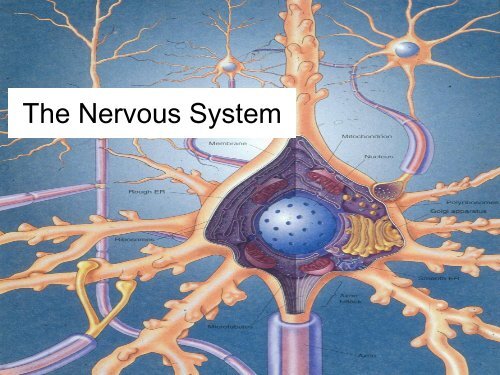The Nervous System
The Nervous System
The Nervous System
You also want an ePaper? Increase the reach of your titles
YUMPU automatically turns print PDFs into web optimized ePapers that Google loves.
<strong>The</strong> <strong>Nervous</strong> <strong>System</strong>
• <strong>Nervous</strong> <strong>System</strong>master controlling& communicatingsystem of thebody
3 Overlapping Functions of the <strong>Nervous</strong><strong>System</strong>1. Sensory Input-Sensory receptors monitor changes(stimuli)that occur outside/inside thebody2. Integration-Interpret and make decisions about whatshould be done at the moment3. Motor Output-A response to the sensory receptor(movement, gland excretion)
Organization of the <strong>Nervous</strong> <strong>System</strong>• Central <strong>Nervous</strong><strong>System</strong>– Brain and spinal cord– Found in the Dorsal bodycavity– Integrates sensoryinformation.
Organization of the <strong>Nervous</strong> <strong>System</strong>• Peripheral <strong>Nervous</strong><strong>System</strong>– nervous system outsideof the CNS– nerves coming from thebrain and spinal cord.
• Histology:– <strong>Nervous</strong> tissueconsists ofneurons andsupporting cells• Neurons (nerve cells)– transmit impulses– Can live 100 years– Cannot be replaced ifdestroyed– High metabolic rateHistology -
Anatomy of a Neuron• All neurons containthe following:
Anatomy of a Neuron• Cell body– Containsnucleus.– Metaboliccenter of the cell
Anatomy of a Neuron• Dendrites– Short extensions fromcell body– Conduct nerveimpulses towards thecell body– Each neuron mayhave many dendrites.
Anatomy of a Neuron• Axons– can be short or long– Conduct nerveimpulses away fromthe cell body– Only one per neuron• may have thousandsof terminal branches.
Synapse-<strong>The</strong> spacebetweenneurons
Structures Vital to Nerve Conduction• Myelin– White fatty material– Protects/insulates neuron– In the PNS• Axons myelinated by schwann cells• Each cell wraps around the axon like a jelly roll.– Neurilemma – “neuron husk”. External to themembrane– In the CNS• Oligodendrocytes myelinate nerve fiber– No neurilemma
Nerve Impulse• A nerve impulse has two properties:– Irritability: the ability to respond to astimulus and convert it into a nerveimpulse– Conductivity: the ability to transmit theimpulse to other neurons, muscles, or glands.
HISTOLOGY: CNS SupportingCells• CNS Supporting Cells – called neuroglia (nerveglue)– Support– insulate– protect• TYPES of NeuroGlia:– Astrocytes– Microglia– Ependymal– Oligodendrocytes
On the next 4 slides - Predict the function of theneuroglia of the CNS based on the structure of thecells and their location.
CNS Supporting Cells• Predictions?• Astrocytes– Abundant– star shaped cells– account for nearly halfof the neural tissue– Form a protectivebarrier betweencapillaries and neurons– Brace neurons– Anchors neuron to theirnutrient supply
CNS Supporting Cells Predictions? Microglia Spiderlike Dispose of debris(dead cells) protect the cell frommicro-organisms
CNS Supporting Cells Predictions? Ependymal cell line the cavities of the brain and spinal cord Beating of cilia circulates cerebrospinal fluid
CNS Supporting Cells Predictions? Oligodendrocytes few branches Wrap around nervefibers to protect andinsulate (myelinsheaths).
PNS Supporting CellsPredictions?Schwann Cells Form the myelin sheathsSatellite cellssurround the cell bodyFunction unknown
Structure of Neurons• Structure of Neurons are organized bynumber of processes extending from cellbody– unipolar– bipolar– multipolar
Unipolar Neuron– Have a single process• mostly sensory organs
Bipolar Neuron– Have two processes• special sense organs
Multipolar Neuron– Have many processes• All motor neurons
• Efferent Neurons– Conduct nerve impulses away from CNS– Cause an effect• Afferent Neurons– Conduct nerve impulses toward the CNS– Are affected
Afferent or Efferent ?1. Does the blue line represent an afferent or efferent neuron?2. Does the red line represent an afferent or efferent neuron?
<strong>Nervous</strong> <strong>System</strong>CNSPNSStructural ClassificationAfferent(sensory)Efferent(motor)Functional ClassificationAutonomic(involuntary)Somatic(voluntary)Sympathetic“fight or flight”Parasympathetic“rest & digest”


